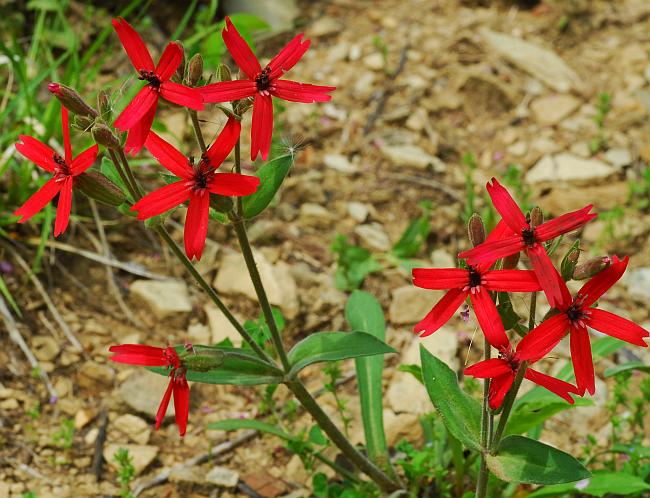Silene virginica L.
Fire Pink

Native
CC = 7
CW = 5
MOC = 39
© SRTurner
Silene virginica L.Fire Pink | |
 |
Native CC = 7 CW = 5 MOC = 39 |
© SRTurner |
|
Family - Caryophyllaceae Habit - Perennial forb from a woody caudex and branched rootstock. Stems - Erect, to 70 cm long, unbranched or branched at the base, moderately to densely pubescent with viscid stalked glands, sometimes glabrous or nearly so toward the base.
Leaves - Basal leaves usually numerous at flowering, with vegetative offsets frequently also present nearby, the largest much longer than the largest stem leaves, short-to more commonly long-petiolate. Stem leaves opposite, in 2-4 widely spaced pairs, sessile. Leaf blades 1-12 cm long, those of the basal leaves narrowly to broadly oblanceolate or spatulate, those of the stem leaves reduced upward, oblanceolate to narrowly oblong-elliptic or lanceolate, tapered at the base, angled or tapered to a usually sharply pointed tip (a few of the smaller basal leaves sometimes rounded or bluntly pointed), the surfaces glabrous or short-hairy and/or with stalked glands.
Inflorescence - Loose terminal bracteate cymes. Pedicels 0.4-2.0 cm long, densely glandular pubescent. Bracts paired and resembling small leaves, with herbaceous, green margins.
Flowers - Perfect. Sepals 16-21 mm long, the tube with 10 parallel, nonanastomosing nerves, more or less tubular at flowering, becoming somewhat inflated and broadly club-shaped at fruiting, green or purplish-tinged, slightly paler and sometimes slightly translucent (at fruiting) between the nerves, with stalked glands, the lobes lanceolate to triangular, green to purple, bluntly or sharply pointed at the tip, the margins herbaceous and green or thin and white to reddish-tinged. Petals 5, clawed, 30-45 mm long, the expanded portion 10-19 mm long, notched at apex, glabrous, bright red, with a pair of small appendages on the upper surface at the base of the expanded portion. Stamens 10, half adnate at base of petals, half not adnate to petals, exserted. Filaments 2.4 cm long, glabrous, greenish-white below, reddish near apex. Anthers 3 mm long, 2-lobed, greyish-green. Ovary on small gynophore (to 1.5 mm long), cylindric, yellow-green, 6 mm long. Placentation free-central. Ovules numerous. Styles 3, white below, red above, 2 cm long.
Fruits - Capsules 14-17 mm long, dehiscing apically by 6 teeth, with a stalklike basal portion 2-3 mm long. Seeds 1.0-1.2 mm wide, kidney-shaped, the surface with large, somewhat bulbous papillae, gray.
Flowering - April - June. Habitat - Bottomland and mesic forests, streambanks, bases and ledges of bluffs, pastures. Origin - Native to the U.S. Lookalikes - S. regia. Other info. - This showy species can be found in the Ozark section of Missouri. It also occurs throughout the lower U.S. Midwest, reaching eastward to the Atlantic Coast in a few spots. The species is hard to miss and easy to recognize, with its conspicuous bright red flowers with notched petals. The appearance is similar to the closely related but less common S. regia, except that that plant is taller and leafier, and has flower petals which are not notched. Like many other members of the genus, this plant is often seen with bits of dirt or other debris clinging to various parts, due to their sticky glandularity. Photographs taken in Brown Summit, NC., 5-1-02 (DETenaglia); also at Valley View Glade Natural Area, Jefferson County, MO, 4-28-2010, and Washington State Park, Washington County, MO, 4-21-2015 and 4-18-2016, Silver Mines Recreation Area, Madison County, MO, 4-28-2020, and St. Joe State Park, St. Francois County, MO, 5-5-2025 (SRTurner). |